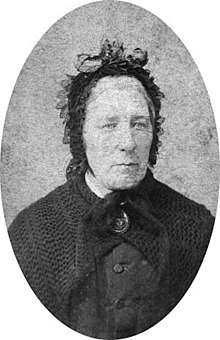Margaret Bethune
Margaret Bethune (2 October 1820 – 20 April 1887), born Margaret Peebles, was a Scottish midwife who kept a detailed register of almost 1300 births she attended in Largo parish in Fife. Her register survives as a rich record for the history of midwifery in Scotland.
Margaret Bethune | |
|---|---|
 | |
| Born | 2 October 1820 Peebles, Scotland |
| Died | 20 April 1887 (aged 66) Largo, Fife, Scotland |
| Nationality | Scotland |
| Occupation | Midwife |
Early life
Bethune was born in Peebles, the daughter of Margaret Walker, a linen worker, and Andrew Peebles, a weaver of Lundin Mill.[1]
Career
In order to provide for her young children and elderly mother, the widowed Bethune moved from Largo to Edinburgh in 1852, to seek midwifery training.[2][3] She purchased a copy of Alexander Hamilton's Concise Rules for the Conduct of Midwives in the Exercise of their Profession, published in 1793, and gained a ticket to work on the wards at a maternity hospital in Edinburgh.[1][4]
Bethune returned to her family in 1853, and began working as a midwife or "howdie" in her community.[5][6] Bethune kept a casebook, recording 1,296 labours she attended, all within the parish of Largo, with only two maternal deaths registered.[7] She was a respected and able midwife, and she attended to the vast majority of births in her parish for several decades.[8]
Personal life and legacy
In 1844, she married William Bethune, a coal miner. They had two children, Margaret (born 1845) and William (born 1847). She was widowed at age 32, when her husband died in a mining accident. Margaret Bethune died from heart disease in Largo in 1887, aged 66 years.[1] Her casebook is preserved in the National Records of Scotland.[7] Bethune's register was featured in a 2015 exhibit in Edinburgh, marking the centenary of the Midwives Act of 1915.[9][10]
References
- Mortimer, Barbara E. "Bethune [née Peebles], Margaret (1820–1887), midwife". Oxford Dictionary of National Biography (online ed.). Oxford University Press. doi:10.1093/ref:odnb/61632. Retrieved 11 May 2020. (Subscription or UK public library membership required.)
- "Safe Delivery: A History of Scottish Midwives". National Records of Scotland. 31 May 2013. Retrieved 14 May 2020.
- Borsay, Anne; Hunter, Billie (15 May 2012). Nursing and Midwifery in Britain Since 1700. Macmillan International Higher Education. ISBN 978-1-137-29416-6.
- Rafferty, Ann Marie; Robinson, Jane (4 August 2005). Nursing History and the Politics of Welfare. Routledge. pp. 146, note 27. ISBN 978-1-134-77354-1.
- "Exhibition to celebrate centenary of new standards for midwives". The Courier. 12 October 2015. Retrieved 27 July 2020.
- Pauline Cairns Speitel, "Scots Word of the Week: Howdie" Scots Language Centre.
- Margaret Bethune, register of deliveries (1853-1887), in the National Records of Scotland.
- Ewan, Elizabeth L.; Innes, Sue; Reynolds, Sian; Pipes, Rose (27 June 2007). Biographical Dictionary of Scottish Women. Edinburgh University Press. p. 34. ISBN 978-0-7486-2660-1.
- Ford, Steve (12 October 2015). "Scottish midwives celebrated in new records exhibition". Nursing Times. Retrieved 27 July 2020.
- Smith, Gillian (2015). "Centenary Celebrations". Midwives. 18: 55 – via ProQuest.
External links
- Cameron, Anne Marie. From ritual to regulation? The development of midwifery in Glasgow and the West of Scotland, c.1740-1840 (PhD dissertation, University of Glasgow 2003).